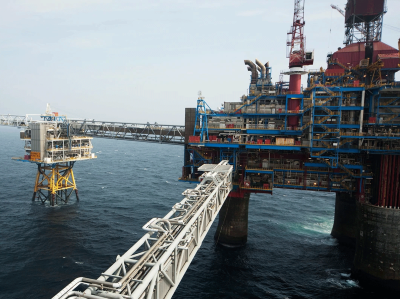
Jubilation over reaching an agreement on climate-change measures has turned to concern about the practicalities of making them work.Credit: Jonathan Raa/Pacific Press/LightRocket/Getty
That photograph: the one taken in Paris in December 2015, showing beaming world leaders with linked hands held overhead, celebrating their agreement to work together to stop anthropogenic climate change. It marked a turning point in international climate policy. After more than two decades of disagreements, the world had finally united, both in recognizing the threat of global warming and in pledging to take action. But what action means in practical terms has always been unclear. At the time, researchers shared with Nature their doubts about the feasibility of achieving the goal to keep the rise in global temperatures “well below 2 °C”, while “pursuing efforts” to limit it to 1.5 °C.
Scientists had good reason to be sceptical. Under most plausible scenarios, average temperatures will overshoot the 1.5 °C target — a fact that was confirmed in a 2018 special report from the Intergovernmental Panel on Climate Change. The report suggests that, to extract enough carbon dioxide from the atmosphere to bring the temperature rise below the limit, methods to remove carbon from the atmosphere — yet to be tested at scale — will be needed. Scientists had other unanswered questions, too: what will happen while temperatures are above the threshold? How hard will it be to reverse the rising mercury in our thermometers?
Overshooting global-warming limits is a risky idea
Answers are now emerging, and some of them should make us all pay attention and ask again whether people and planetary health can withstand the effects of temperature overshoots. This week in Nature, a team led by Carl-Friedrich Schleussner at Climate Analytics, a non-profit research institute in Berlin, reports that even a temporary overshoot will allow climate impacts to accumulate over the next several decades (C. F. Schleussner et al. Nature 634, 366–373; 2024).
These impacts would include more severe storms, heatwaves and the destruction of ecosystems, and it won’t be easy to extract enough CO2 from the atmosphere to reverse course. Research is showing that the space for viable alternatives is limited. As world leaders and climate diplomats meet at next month’s United Nations COP29 meeting in Baku, Azerbaijan, they need to take note: the wisest solution to tackle ballooning emissions is to cut, cut, cut.
It’s not that carbon-removal methods don’t work. Some do. The simplest is, of course, planting trees. More-complex measures include extracting carbon directly from the atmosphere. But as Schleussner and his colleagues estimate, up to 400 gigatonnes of carbon would need to be removed from the atmosphere by 2100 to limit warming to 1.5 °C, assuming current emissions trajectories continue. In emissions terms, that is equivalent to running the US energy industry in reverse for around 80 years.
Even assuming that removing that amount of carbon is feasible, some Earth systems will probably not be restored to their previous equilibrium. Some changes, such as rising oceans, shifting ecosystems and regional climate change, are likely to endure, and will have lasting impacts on agriculture, and other industries. There is “no expectation of immediate reversibility after overshoot”, the authors argue. For many people, the climate that they will experience after overshoot will not be what they had experienced before it — even if global mean surface temperatures return to levels before the overshoot.
Top climate scientists are sceptical that nations will rein in global warming
Moreover, higher temperatures, even for a brief period, increase the risk of hitting tipping points that could kick the Earth system, or parts of it, into a completely new state, a conclusion underscored in an August study in Nature Communications by Annika Högner at the Potsdam Institute for Climate Impact Research in Germany and Tessa Möller at the International Institute for Applied Systems Analysis in Laxenburg, Austria (T. Möller et al. Nature Commun. 15, 6192; 2024) and their colleagues.
The authors also find that the risk of crossing climate tipping points increases as successive increments above 1.5 °C are reached. The higher the overshoot, the greater the risk of irreversible events -— such as total collapse of the Greenland ice sheet or dieback of the Amazon rainforest — even if carbon-removal technologies successfully bring the warming back to within 1.5 °C.
Nearly a decade on from the Paris agreement, the world is already on the brink of the 1.5 °C threshold and people and ecosystems in low-income countries will bear the brunt of the impacts, even though they are the least responsible. “Overshoot entails deeply ethical questions of how much additional climate-related loss and damage people, especially those in low-income countries, would need to endure,” Schleussner and his colleagues write.
The increasing likelihood of an overshoot requires research and development of carbon-removal technologies, but first the world needs to stop pumping carbon into the atmosphere. On 30 September, the United Kingdom set an example by shutting down its last coal-fired power plant and announced investments of nearly £22 billion (US$29 billion) over the next 25 years in carbon capture and storage technologies. The projects will be situated in two of the country’s poorest coastal regions, bringing much-needed skilled jobs, training and research to areas that have been hit hard by deindustrialization. These efforts are a start.
Governments and industry must have a laser-like focus on the risks ahead and how to mitigate them. This means nothing less than aggressively cutting emissions and helping communities to become resilient to the impending shocks. To wait and scrub the atmosphere later is to court disaster — for people and the planet.




